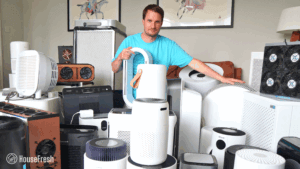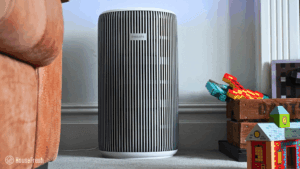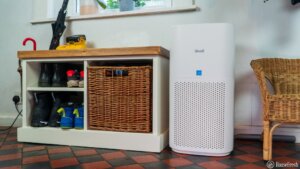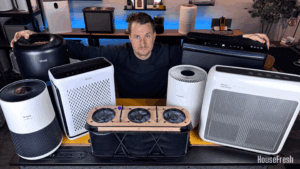“What if I told you that a silent, invisible threat in your home is becoming more deadly every year?”
“Back in 1969, only 450 deaths in the U.S. were linked to mold and fungal infections. By 2021, the figure had skyrocketed to over 7,000 deaths, according to data from the CDC.”
Stories like these are terrifying. And this fear of a hidden danger in your home is exactly the kind of thing some air purifier manufacturers use to sell you overpriced machines with promises they can’t always keep.
In this article, we’re cutting through all that marketing hype as I’ll explain what you need to know about mold, air purifiers and humidity before you waste your money. Let’s start with a very important question.
Do you need an expensive HEPA filter to remove mold?
Before you start shopping for an air purifier, you need to understand what you’re trying to catch.
The airborne spores from molds such as Aspergillus measure 2 to 5 microns wide, so they can be easily removed from the air using many different types of particle filters.
While marketing materials attached to specific air purifier models suggest you need HEPA H13 or even H14, the reality is that a higher-grade filter can actually reduce the speed at which you can remove mold spores from the air because the filter itself is much denser and restricts airflow.
Your house is not an operating theater, so instead of trying to remove the most particles in a single pass with a medical-grade HEPA filter, focus on finding an air purifier powerful enough to provide multiple air changes in the room with the mold issue. To do this, focus on Clean Air Delivery Rate (CADR), which is the volume of filtered air the air purifier can deliver.
So instead of obsessing over filter grades, I suggest you focus on whether the air purifier you are considering has a high enough CADR to provide 4-6 air changes per hour in your room. You can use our CADR calculator to figure out what CADR you need for your room.
Three more points:
- Avoid those small, popular air purifiers with a CADR below 100 cfm. Unless you’re planning to use the air purifier in a tiny closet, small units simply won’t have the strength needed to clean the air quickly enough.
- For most people, an air purifier with a CADR of at least 200 cfm will do. A 200 cfm air purifier can provide 4 air changes in spaces up to 375 sq. ft. or 6 air changes in rooms up to 250 sq. ft.
- CADR can be maximized with a lower-grade filter, such as MERV 13 or E11. However, moving to lower filter grades, such as MERV 8, will lead to lower CADR because, even though airflow is higher, the filter efficiency is not high enough.
Alright, that’s enough theory. Let’s get into my recommendations…
Best for basements: Levoit Core 600S
Most people who reach out asking for a mold recommendation mention their basement. My top pick is this $300 air purifier from Levoit.

If you’re looking for a unit for a damp basement with humidity levels above 60%, I recommend looking for a high-CADR model with a hardy case that can be wiped down regularly to remove moisture and minimize the risk of mold growth on the filter. My pick is the largest air purifier from Levoit: the Core 600S.
I bought my 600S back in 2022, and it’s still going strong.
In fact, I recently retested everything about it, and it cleaned our test room faster than more expensive models like the Xiaomi Elite or the Winix 9800.

The only issue is that it runs loud at top speed, hitting 62.3dBA, but this shouldn’t be an issue in most basements – unless you’re spending a lot of time down there.

The device itself is made entirely out of plastic, so it’s easy to clean.
Be aware that, at 23.6 inches (60 cm) tall, it is the largest model in Levoit’s Core range of air purifiers—see how it compares to the Core 300S (left) and the Core 400S (middle).
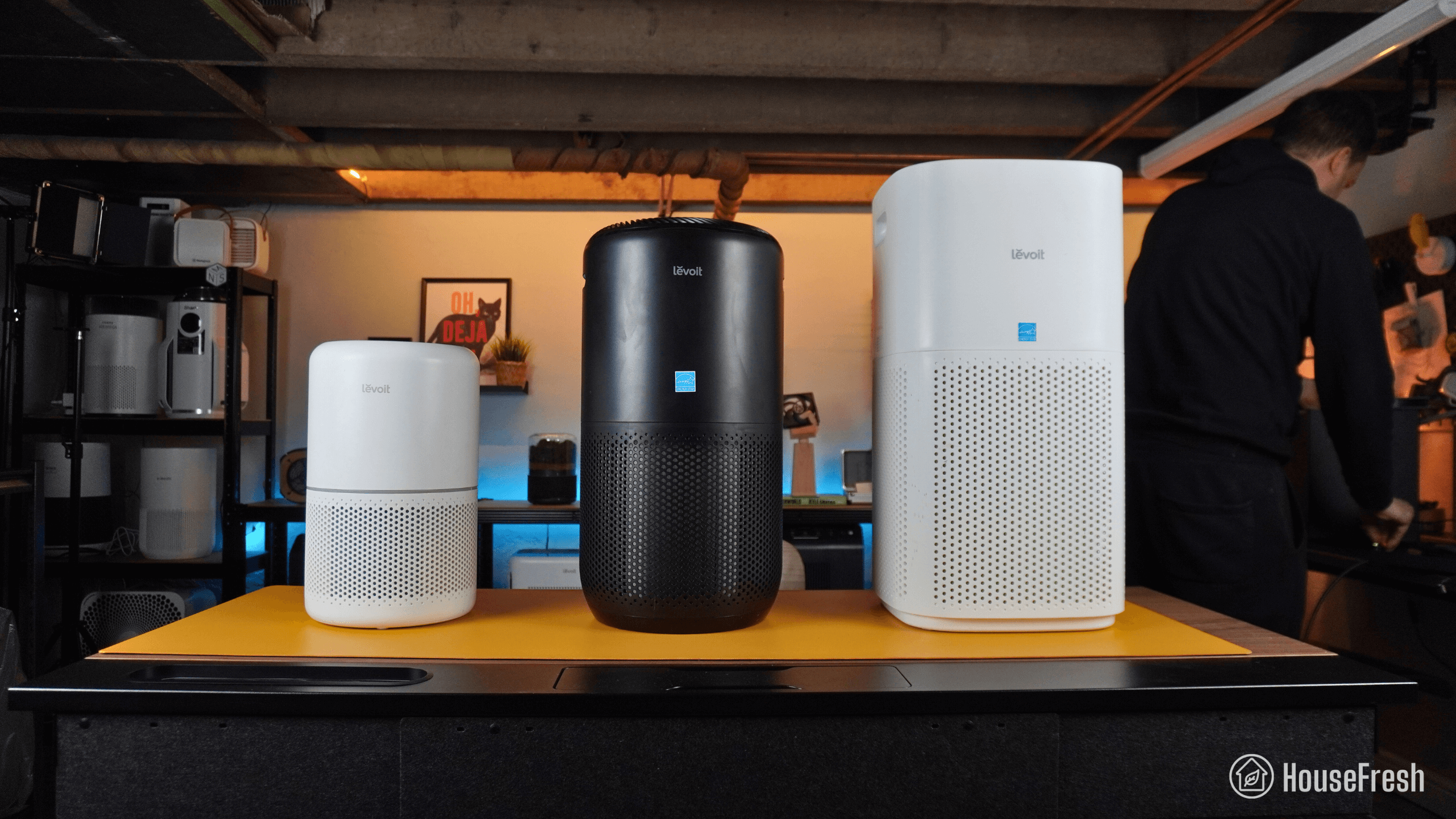
When buying filters, you can choose from Standard, Pet Allergy, Smoke Remover, or Toxin Absorber. The main difference between them is the amount of carbon they have. For mold, stick with the Standard filter.
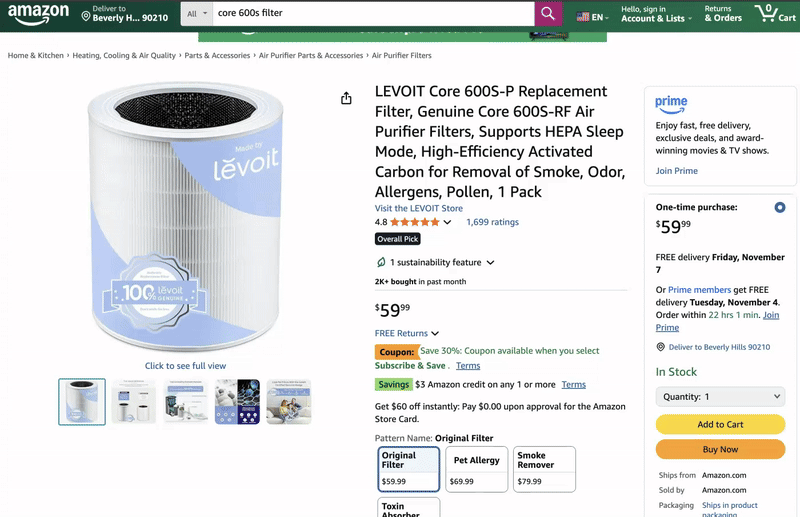
You can also connect the 600S to your phone via the VeSync app to control it remotely, set automations, and even customize the auto-mode.
| Clean air delivery rate (CADR): | – Top speed PM1 CADR: 375 cfm – Sub-45 dBA PM1 CADR: 156 cfm – AHAM PM2.5 CADR: 398 cfm (dust) |
| Filter technology: | Bonded particle filter with a layer of pelleted activated carbon and a pre-filter mash wrap. |
| Recommended room size: | 562 sq. ft. (5 air changes per hour) |
| Dimensions: | 12.3 x 12.3 x 23.6 inches (31.3 x 31.3 x 60 cm) |
| Weight: | 13.7 lbs (6.2 kg) |
| Noise level in decibels from 3 ft. away: | Sleep: 37.9 dBA Speed 1: 44.4 dB Speed 2: 45.9 dB Speed 3: 53.8 dBA Speed 4: 62.3 dBA |
| Electricity consumption in watts: | Standby mode: 1.3 watts Sleep: 4.33 watts Speed 1: 7.46 watts Speed 2: 10.7 watts Speed 3: 20.29 watts Speed 4: 48.1 watts |
| Filter lifespan: | 6-12 months |
| Manufacturer’s warranty: | 2 years |
| Country of origin: | United States |
| Country of manufacture: | China |
Best budget option: Corsi-Rosenthal Box
If you don’t care about smart features and want to save some money, you can just build your own large CADR air purifier.

My top budget pick for large spaces is the Corsi-Rosenthal Box, a DIY device you can build yourself using a box fan, four MERV 13 filters, and a cardboard base. The combination yields a high CADR at a very low cost.
We tested two versions of the Corsi-Rosenthal Box, and the design with larger 3M 30×20 MERV 13 filters reached the top of our leaderboard as one of the fastest air purifiers in our particle removal test.
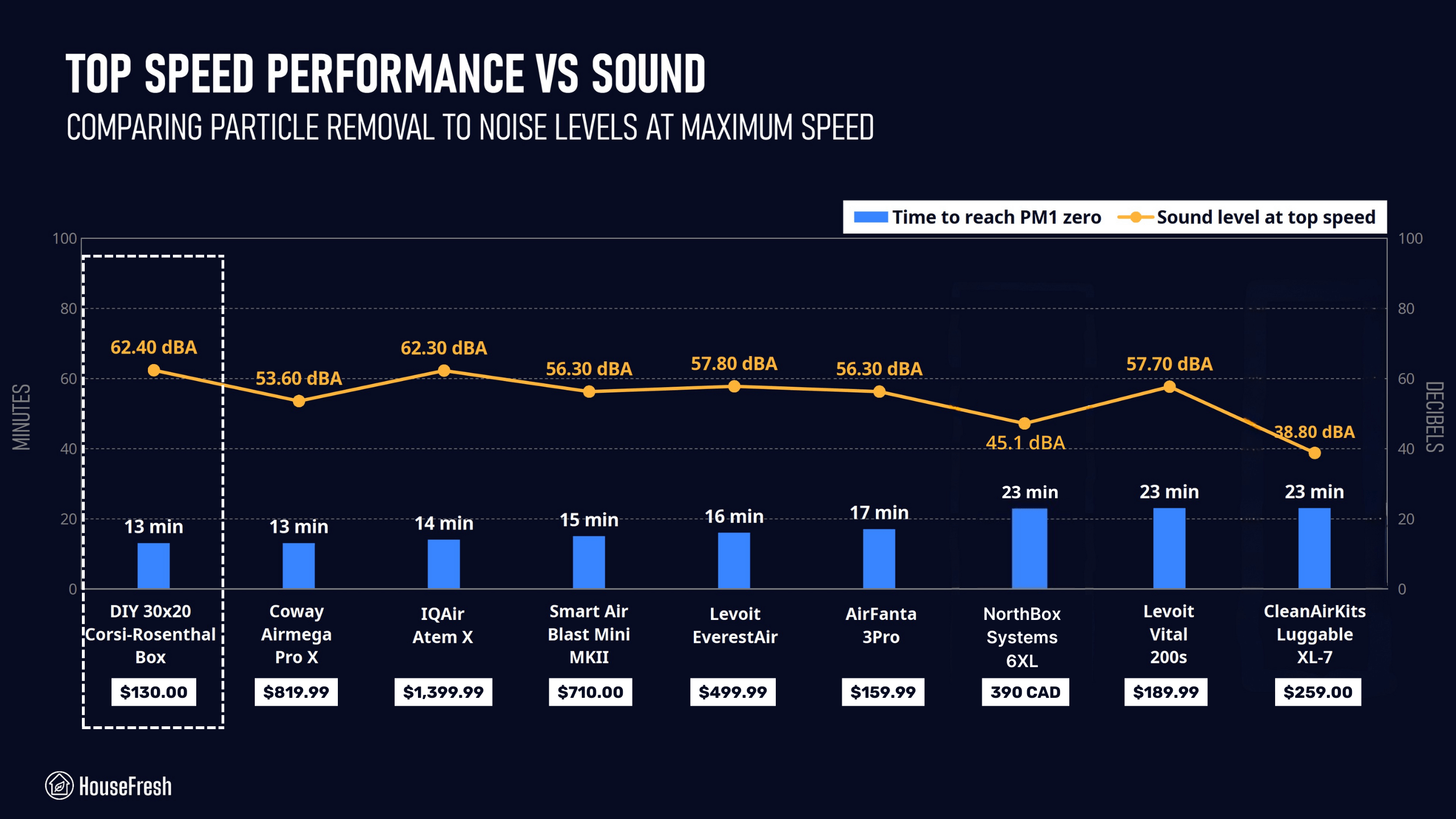
Based on the natural ventilation of our test room, we estimated a PM1 CADR of 462 cfm for our 20×30 CR box, which is incredible for something that costs less than $140.
To build it, we used a Lasko box fan and four 20X30 3M Filtrete MPR1900 filters.
Now, there are some issues with Corsi-Rosenthal boxes: they run loudly and can be power-hungry. Plus, they take up a lot of space — this is especially true for our 20×30 CR box.
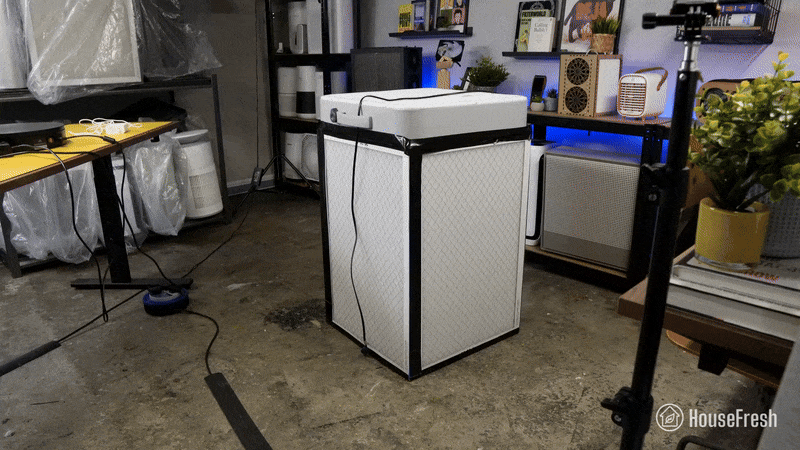
However, the Corsi-Rosenthal Box is hard to beat for raw performance for the least amount of money upfront. And any savings you make can be put towards a long-term solution that I will discuss later in the article.
| Tip: By the way, if you’re building a CR box for a very damp basement, I recommend adding some legs so the cardboard base doesn’t end up sitting on a wet floor. |
| Clean air delivery rate (CADR): | – Top speed PM1 CADR: 462 cfm |
| Filter technology: | 3M Filtrete 20x30x1 MERV 13 MPR 1900 filters |
| Recommended room size: | 693 sq. ft. (5 air changes per hour) |
| Dimensions: | 20 x 20 x 35 in (51D x 51W x 89H cm) |
| Weight: | 11.26 lbs (5.1 kg) |
| Noise level in decibels from 3 ft. away: | Speed 1: 51.5 dBA Speed 2: 58.3 dBA Speed 3: 62.4 dBA |
| Electricity consumption in watts: | Standby: 0 watts Speed 1: 72.57 watts Speed 2: 88.55 watts Speed 3: 103.28 watts |
| Filter lifespan: | 6-12 months |
Best for bedrooms: PC fan air purifiers
For those looking to remove mold spores from the air in their bedroom, I highly recommend considering air purifiers powered by PC fans.

PC fan air purifiers revolutionized the air purifier market by providing high CADR at low noise levels. Unlike the loud box fans used in CR boxes, these devices use the same ultra-quiet, high-airflow fans found in gaming PCs, designed to move a lot of air without making much noise.
- If you’re in the U.S. or the UK, you have the Luggable XL-7 from CleanAirKits.
- If you’re in Canada, there’s the team at Northbox Systems with their 6XL.
- If you’re in Europe, you can go with the smaller Nukit Tempest Euro.
- And if you live in Australia or around Asia, there’s the AirFanta 3Pro.
All the models I recommend above performed very well in our particle removal test, in many cases outperforming units double their size and double their price:
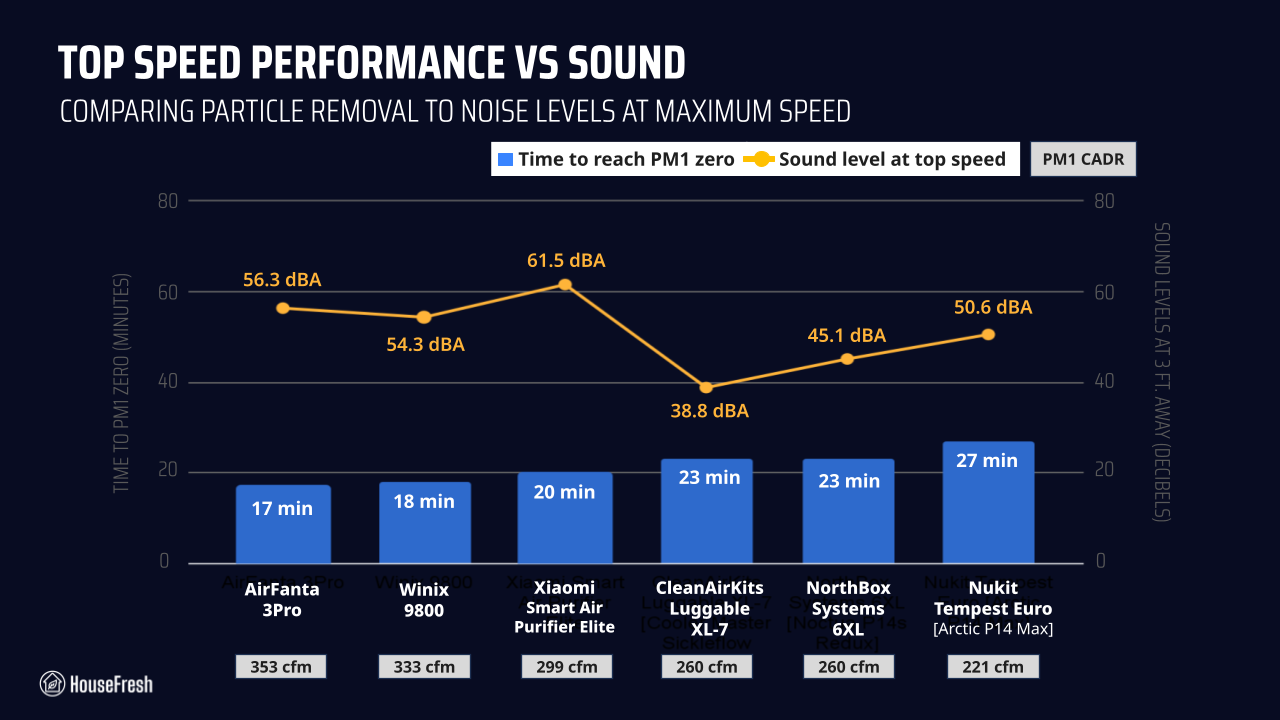
Another advantage of PC fan air purifiers is their low running costs, thanks to the combination of energy-efficient PC fans and affordable filters.
To build CleanAirKits and NorthBox PC fan kits, you can use any type of MERV 13 filter. The Nukit Tempest Euro uses Starkvind E11 filters you can buy at IKEA. And the 3Pro uses proprietary (and fairly priced) filters from AirFanta — you can choose between HEPA-only or HEPA and carbon.
Something to keep in mind: these are DIY kits you will need to build yourself, unless you want to pay extra for a pre-built version, which might not even be available where you live.
If you like the idea of a PC fan-powered device but are not comfortable building one, consider the AirFanta 3Pro, as the assembly process takes just a few minutes and doesn’t require any cable management.

Use the discount code HOUSEFRESH for 5% off when buying directly from AirFanta.
Best for most people: Levoit Vital 200S
If you are looking for a standard air purifier under $200 to help with mold in a medium-sized room, check out the Levoit Vital 200S.
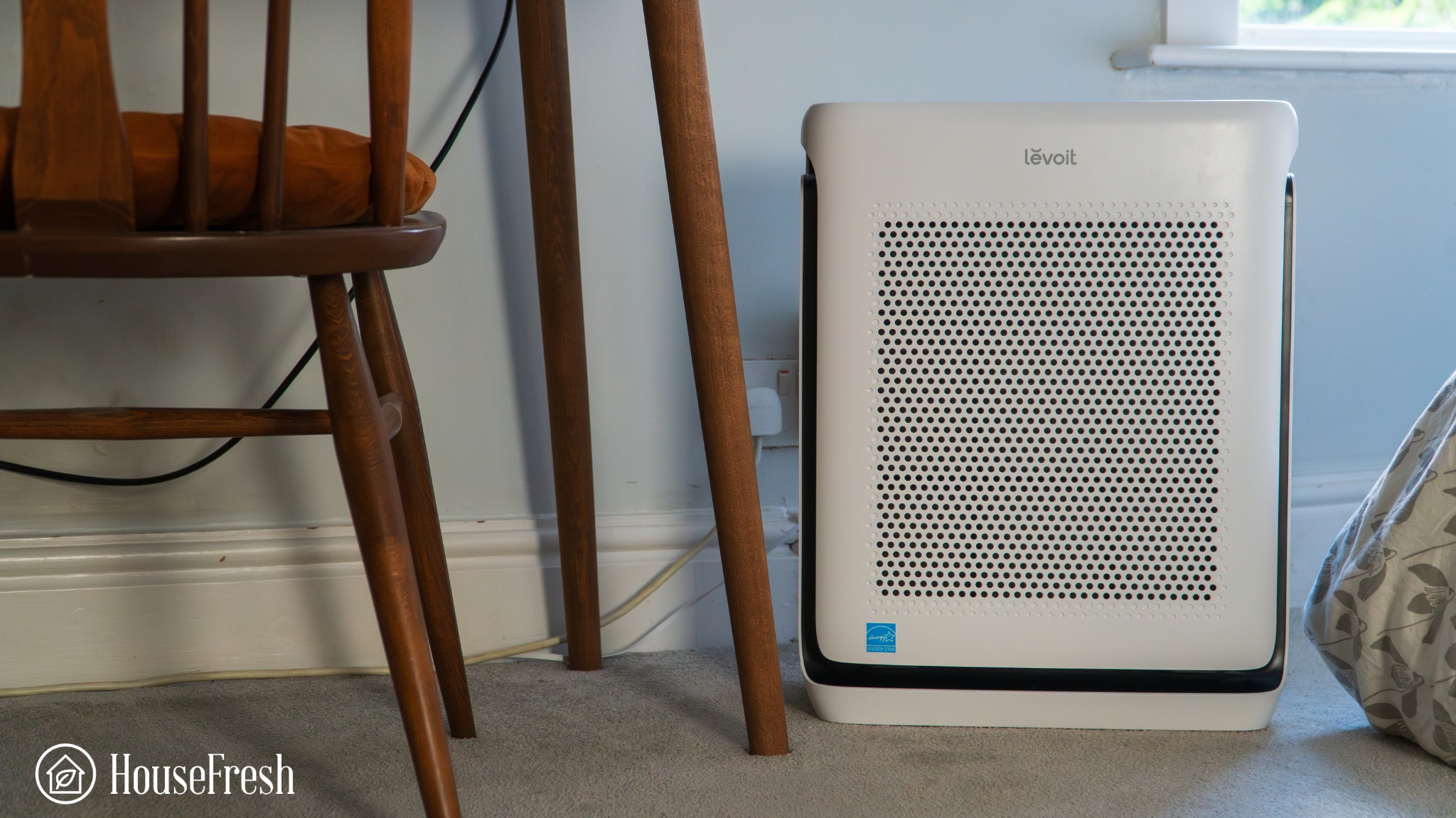
The Vital 200S from Levoit offers good particle removal performance, has a PM1 CADR of 260 cfm that can provide five air changes per hour in rooms up to 375 sq. ft., doesn’t cost an arm and a leg to run, comes with an on-board sensor that unlocks smart features, and has app support. This combination makes it the best option for most people.
In our tests, the Vital 200S performed as well (or better) than air purifier models that are more expensive and have similar features:
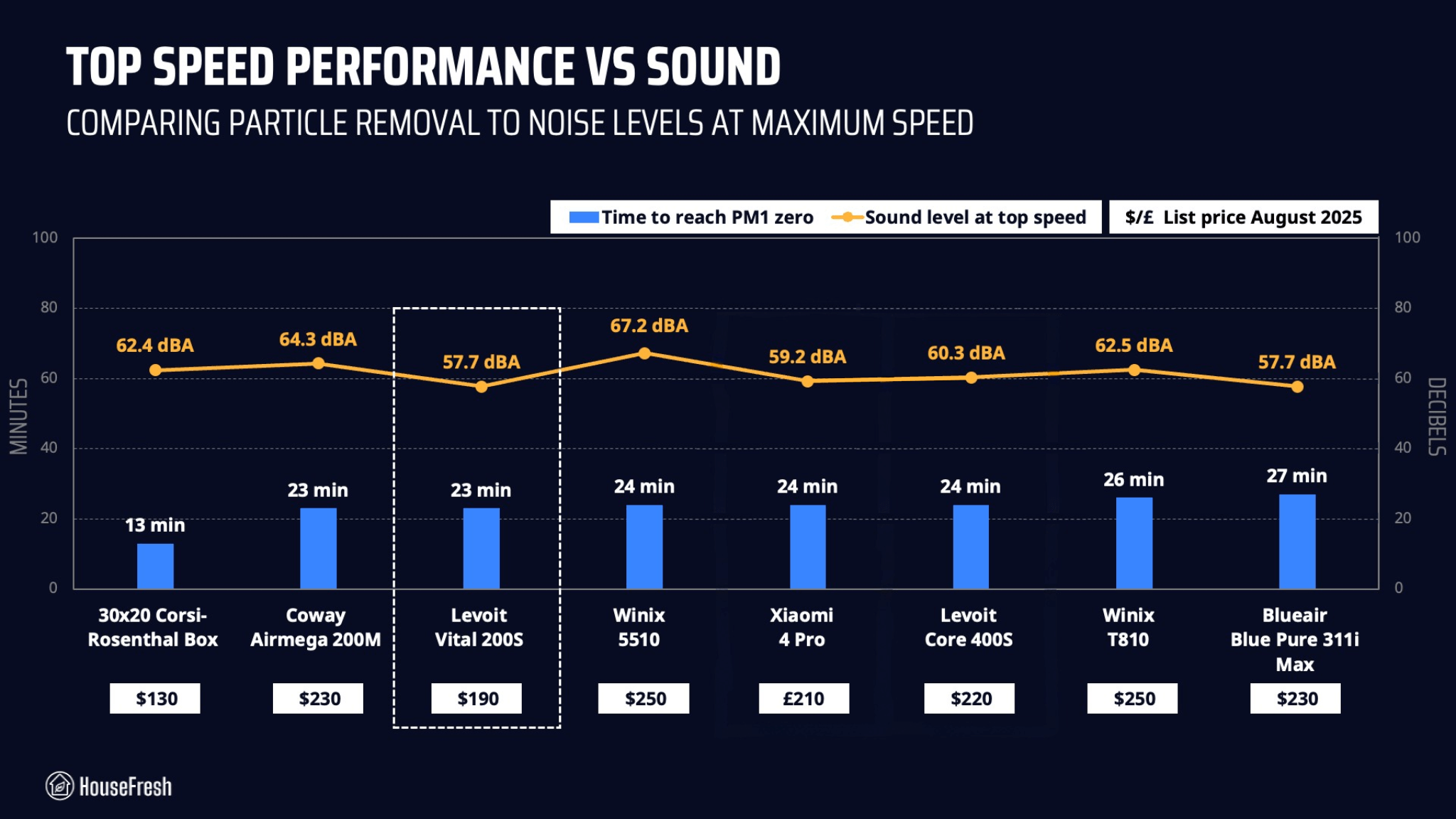
This is a quiet little beast. At speed 2, the Vital 200S generates just 41 dBA of noise while offering a PM1 CADR of 128 cfm. This means it could clean the air in a room up to 192 sq. ft. five times per hour, without disturbing you.
In addition to the particle filtration you’ll need to remove mold spores from the air, the 200S also has a layer of carbon to tackle damp odors.
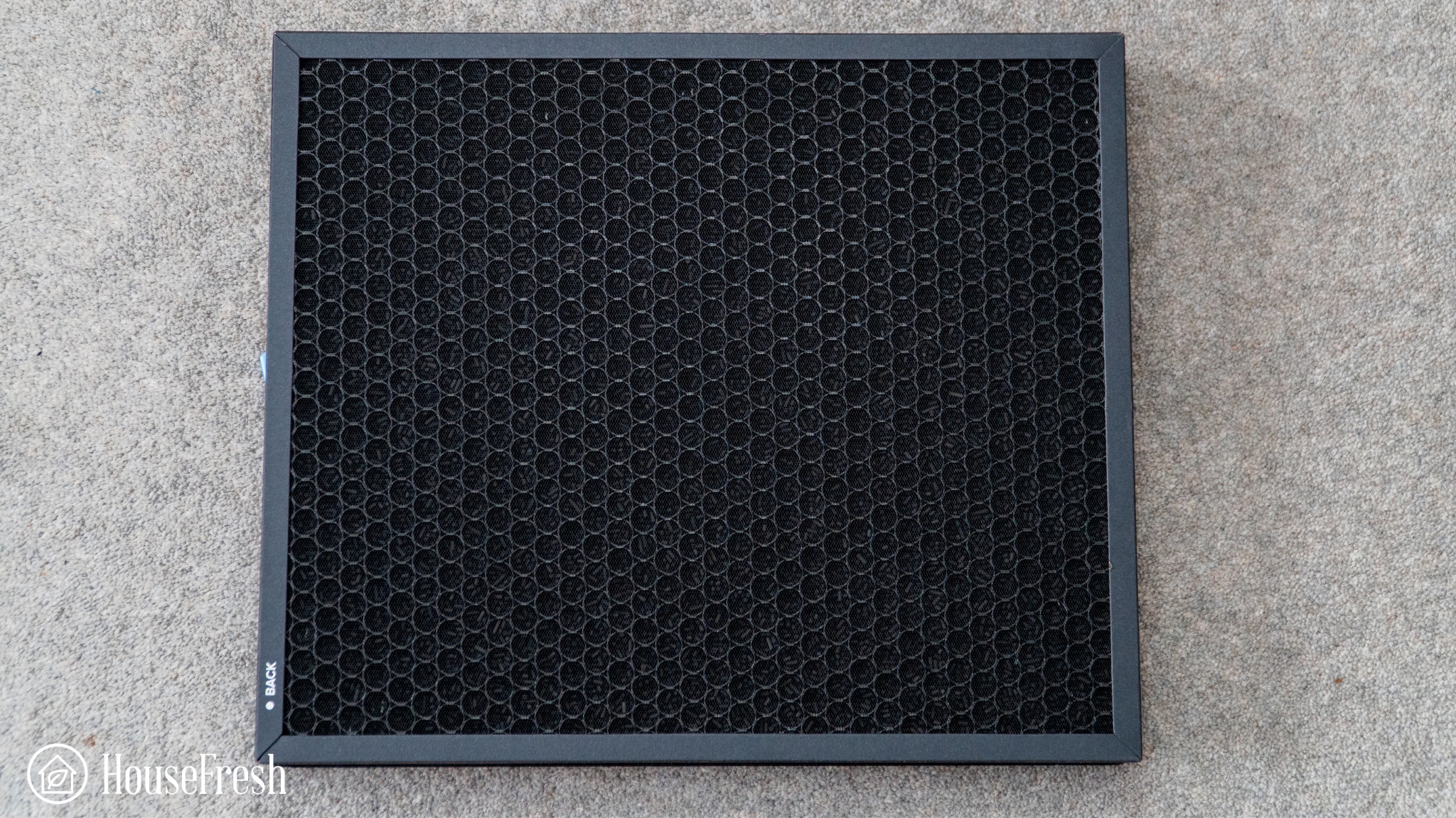
You can connect the Vital 200S to your phone through Levoit’s VeSync app. From the app, you can operate the air purifier remotely, schedule routines, customize auto modes, keep track of filter life, and more.
| Clean air delivery rate (CADR): | – Top speed PM1 CADR: 260 cfm – Sub-45 dBA PM1 CADR: 128 cfm – AHAM PM2.5 CADR: 254 cfm (dust) |
| Filter technology: | Bonded particle filter with a layer of pelleted activated carbon and a removable pre-filter |
| Recommended room size: | 390 sq. ft. (5 air changes per hour) |
| Dimensions: | 15.6D x 8.5W x 19.8H inches (39.3D x 21.5W x 50.2H cm) |
| Weight: | 13.2 lbs (5.9 kg) |
| Noise level in decibels from 3 ft. away: | Speed 1: 38.3 dB Speed 2: 41.9 dB Speed 3: 53.8 dB Speed 4: 57.7 dB |
| Electricity consumption in watts: | Standby mode: 0.97 watts Speed 1: 5.71 watts Speed 2: 8.01 watts Speed 3: 31.96 watts Speed 4: 44.55 watts |
| Filter lifespan: | 12 months |
| Manufacturer’s warranty: | 2 years |
| Country of origin: | United States |
| Country of manufacture: | China |
Special mentions
Two good-performing air purifiers that didn’t make the cut, but that could be a good choice for you.
The models above are my top picks BUT it’s also worth mentioning some other air purifiers with solid air cleaning performance that can help with mold, as I know that everyone has different needs and likes.
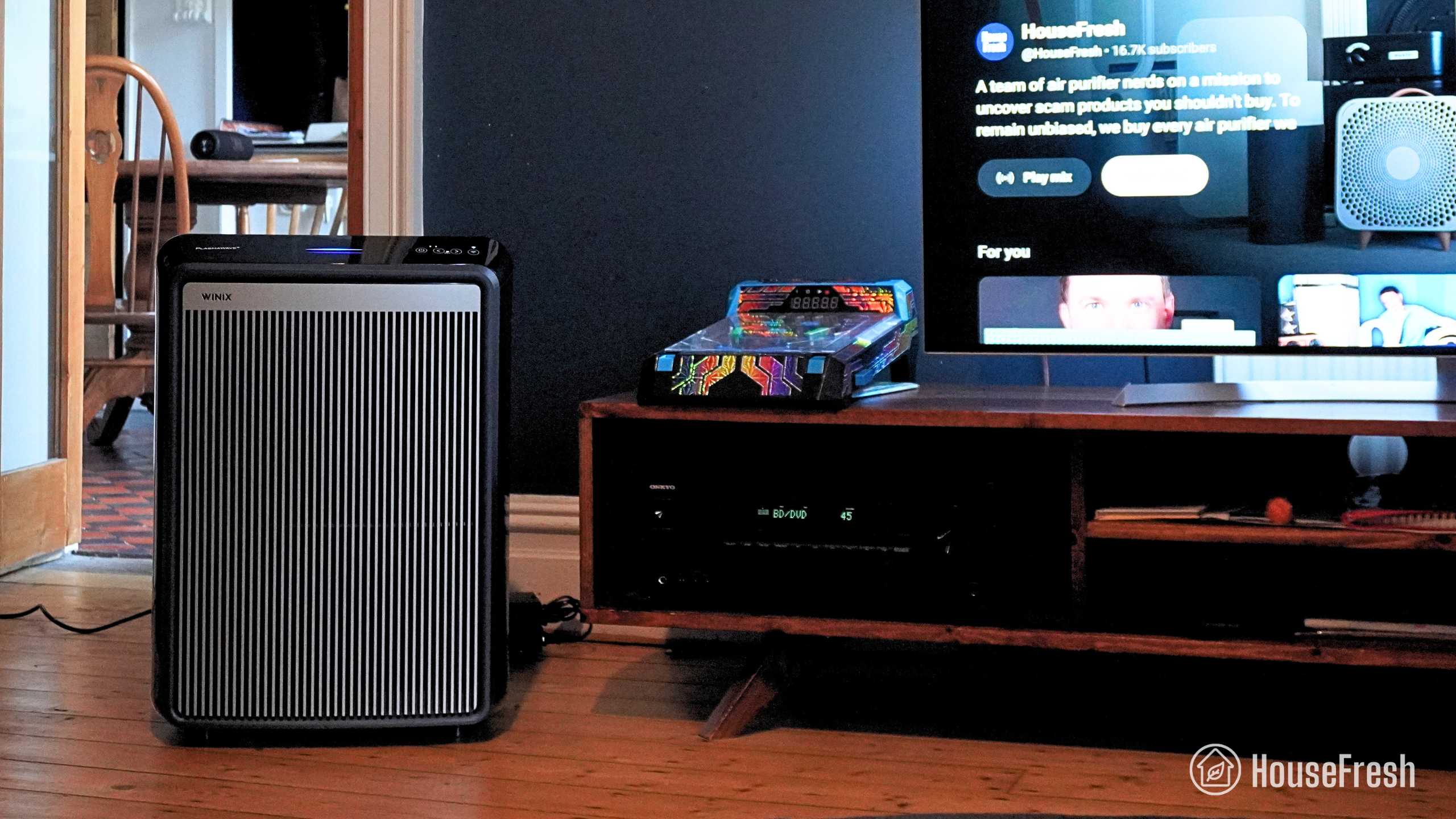
Winix 9800
A medium-sized device with a HEPA filter, an activated carbon filter and a removable pre-filter. With a PM1 CADR of 333 cfm at 54.3 dBA, it offers excellent particle removal performance and app connectivity in a stylish design for $329.
It didn’t make the list because it was outperformed by the Core 600S (PM1 CADR of 375 cfm), which comes at a cheaper list price ($319.99).
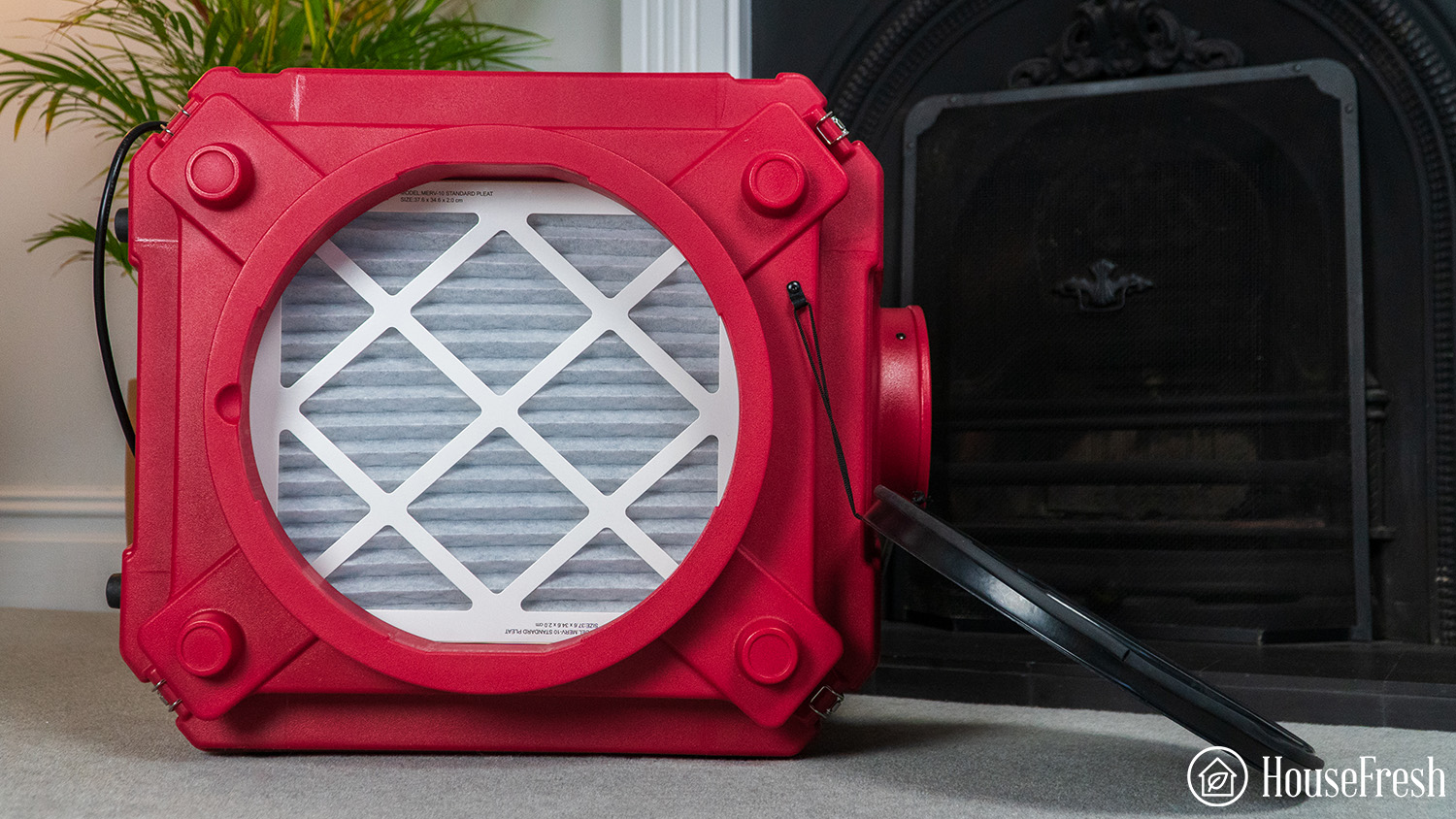
AlorAir Clean Shield HEPA 550
If you’re looking for a powerful air purifier to help remove mold spores in a very damp basement or a damp construction area, then the Clean Shield HEPA 550 might be just the thing.
It has a PM1 CADR of 429 cfm so it can clean the air in spaces as large as 643 sq. ft. five times per hour. But it will do it while generating 74.5 dBA of noise, so it is not suitable for home rooms.
A long-term solution to mold
Understanding why an air purifier alone won’t solve your mold issue.
Okay, you’ve picked the perfect air purifier with the right CADR for your room. It’s removing mold spores from your air 24/7. But if you stop here, you will be fighting this battle forever.
An air purifier removes the symptom, not the cause. To win the war against mold, you must control the one thing it needs to survive: water.
Mold spores are everywhere, all the time, just lying dormant. They only become a problem when the humidity in your home rises, giving them the water they need to wake up and grow. This is why the most important tool in your arsenal isn’t an air purifier; it’s a dehumidifier.
In fact, research has shown that using a dehumidifier in combination with an air purifier has significant effect on overall mold levels.
My number one tip is to avoid mini dehumidifiers and small Peltier devices that cost less than $100, as they are just not effective, so they end up being a waste of money. Instead, stick to refrigerant dehumidifiers and stay away from models with pumps, as they are a common cause of failure. If you want to read more, read my quick guide on how to choose a good dehumidifier.
In my experience, dehumidifier sensors are not always accurate and they generally just measure humidity levels only directly next to the unit. That is why I recommend getting a hygrometer (a relatively cheap humidity sensor) so you can place it in the moldiest corner, and then set the dehumidifier to high until you have been able to bring the humidity below 50%, as research shows that mold starts to grow at 68% relative humidity.
- For those with damp basements, I highly recommend the Midea Cube dehumidifier. It comes with a gravity hose that empties the bucket without needing me to do anything.
- In terms of hygrometers, I’m a big fan of the HT.w from SensorPush. This is the same sensor we use in our dehumidifier tests for tracking levels of humidity every minute.
If you have a limited budget, my tip is to build your own Corsi-Rosenthal box, so you can save some money to buy yourself a dehumidifier as well.
Tackling both the airborne spores AND the humidity is the only way you’ll solve the problem long-term.
I hope this article helped cut through some of the confusion around mold and air purifiers. If you have any questions or if you’ve had your own success story dealing with mold, please drop a comment below, as I’ll reply as soon as I can.


